CBSE Class 4 EVS Air Water and Weather Worksheets with Answers
Q1. The burning of fire needs
(A) oxygen
(B) carbon dioxide.
(C) nitrogen
(D) water vapour.
Answer:
A
The burning of fire needs oxygen.
Q2. Which of the following is NOT true regarding the properties of air?
(A) Air occupies space
(B) Air exerts pressure.
(C) Air has no mass
(D) Air cannot be seen.
Answer:
C
Air is a matter. It has mass.
Q3. When Suresh blew air into a balloon it expanded. This shows that
(A) air has no mass
(B) air fills space.
(C) air has no weight
(D) air is visible.
Answer:
B
Air occupies space.
Q4. Asma took two balloons. She blew air with mouth in one balloon and she filled another balloon with the vapours of boiling water. She released the two balloons and observed that the balloon with the hot vapours rose higher than the other balloon. What did she learn from this experiment?
(A) Hot air is heavier than cold air.
(B) Water vapour gives energy to the balloon.
(C) Air likes hot balloons.
(D) Hot air is lighter and therefore rises higher.
Answer:
D
Hot air has less weight.
Q5. When we blow air into a balloon it expands. What is the reason?
(A) Air is invisible.
(B) Air does not occupy space.
(C) Air has weight.
(D) Air exerts pressure.
Answer:
D
Air exerts pressure on the walls of the balloon and it expands.
Q6. Which of the following does NOT disturb the balance of gases in the air?
(A) Cutting down trees and forests.
(B) Releasing polluting gases into the air.
(C) Growing trees.
(D) Releasing smoke from the vehicles.
Answer:
C
Trees and plants maintain the balance of gases in the air.
Q7. Which of the following changes weather?
(A) The sun
(B) Man
(C) Wood
(D) Television
Answer:
A
The sun changes the weather conditions.
Q9. What is the increase in the temperature of the sand after being placed for an hour in the sunlight?
(A) 30°C
(B) 36°C
(C) 6°C
(D) 3°C
Answer:
C
There is an increase of 6°C in the temperature of the sand after being placed for an hour in sunlight,
Q10. A thick blanket of air surrounding us is called
(A) atmosphere
(B) none of these
(C) nitrogen
(D) cloud
Answer:
A
Q11. The amount of water vapour in air is called
(A) humidity
(B) none of these
(C) moisture
(D) both
Answer:
A
Q12. When we blow air into a balloon, it increases it size because air occupies
(A) space
(B) none of these
(C) shop
(D) volume
Answer:
A
Q.13 Land breeze blows
(A) during the daytime
(B) noon at.
(C) during the nighttime
(D) during mornings.
Answer:
C
Q.14 Land breeze blows during the night.
Sea breeze blows during
(A) evenings
(B) the day time.
(C) the night time
(D) both day and night.
Answer:
B
The sea breeze blows during day time.
Q.15 A student took two dishes P and Q and poured equal amounts of water in them. He placed Dish P in the sunlight and Dish Q in a closed room.
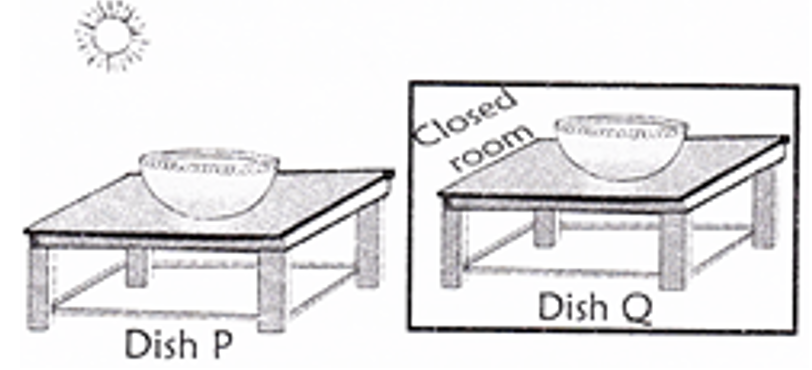
What is the rate of evaporation in dish P and dish Q?
(A) Faster in dish P
(B) Slower in dish P
(C) Faster in dish Q
(D) Same in both the dishes
Answer:
A
Evaporation of water is observed more in dish 'P'.
Q.16 Evaporation increases with
(A) an increase in the amount of water.
(B) a decrease in the temperature.
(C) a decrease in the area of exposure.
(D) an increase in the area of exposure.
Answer:
D
Evaporation increases with an increase in the area of exposure.
Q.17 Ramu took a glass of cold water from the refrigerator and placed it on a table. After a few minutes he observed water drops on the outer surface of the glass. Why did water drops form?
(A) Glass produced water droplets.
(B) The water in the glass seeped -out.
(C) Water vapour present in the air gets condensed.
(D) Water came out from the gaps present in the glass.
Answer:
C
Water vapour in the air gets condensed to form water droplets.
Q.18 The fine droplets observed on the leaves of plants and grass during winter mornings are due to
(A) Snow
(B) Hailstones.
(C) Fog
(D) dew drops.
Answer:
D
Dew drops appear as fine droplets on leaves of plants and grass on a winter morning.
Q.19 Germs present in tap water can be killed by
(A) filtration
(B) condensation
(C) boiling
(D) decantation.
Answer:
C
Germs present in tap water can be killed by boiling.
Q.20 The process by which water vapour changes into water is called
(A) filtration
(B) condensation.
(C) sedimentation
(D) decantation.
Answer:
B
The process of changing water vapour into water is called condensation.
Q.21 Frozen dew is called
(A) frost
(B) rain.
(C) hail stone
(D) water.
Answer:
C
Frozen dew is called hail stone.
Q.22 The figure below shows an activity which was carried out in a laboratory.
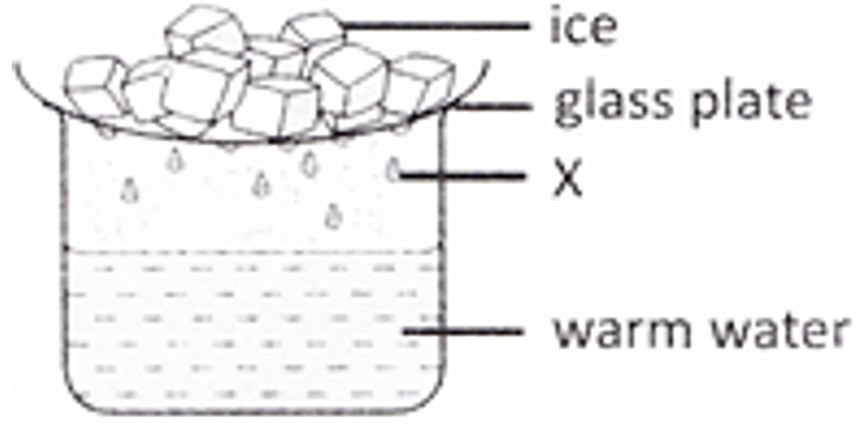
Which of the following phenomena was exhibited by 'X?
(A) Freezing of water
(B) Condensation of water vapour
(C) Evaporation of water
(D) Expansion of water.
Answer:
B
In the given figure 'X' represents the condensation of water vapour.
Q.23 A tight football is heavier than a loose football because air has
(A) weight
(B) none of these
(C) shape
(D) both
Answer:
A
Q.24 Anil poured equal amounts of water into four containers as shown in the figure and kept all of them out in the hot sun for an entire day. At the end of the day, he measured the amount of water left in each container.

What was Anil testing for?
(A) Whether evaporation depends on the volume of water taken
(B) Whether evaporation depends on temperature
(C) Whether evaporation depends on the material of the container
(D) Whether evaporation depends on the exposed area of water
Answer:
D
Evaporation depends on the exposed area of the water.
Q.25 Which two of the gases given below make up more than 95% of air?
(A) Oxygen and carbon dioxide
(B) Oxygen and nitrogen
(C) Nitrogen and carbon dioxide
(D) Nitrogen and inert gases
Answer:
B
95% of the air constitutes oxygen and nitrogen.
Q.26 The diagram given below shows a part of the water cycle.
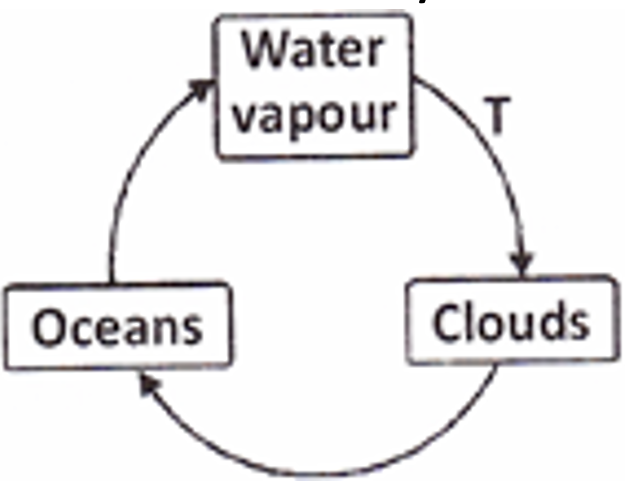
What is the process taking place at the arrow labelled T?
(A) Melting
(B) Condensation
(C) Evaporation
(D) Precipitation
Answer:
B
T represents condensation.
Q.27 The figure given below gives the following observation.
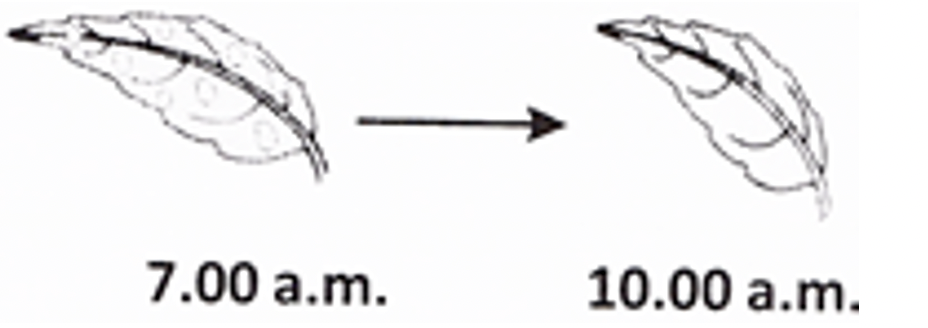
What process causes the dew present on the leaf to disappear by 10.00 a.m.?
(A) Boiling
(B) Evaporation
(C) Condensation
(D) Melting
Answer:
B
The evaporation of dew causes it to disappear.
Q.28 Which disease is caused due to air pollution?
(A) asthma
(B) anaemia
(C) head ache
(D) none of these
Answer:
A
Q.29 Why is the water cycle important to us?
(A) It helps in the recycling of oxygen from the Earth to the sky.
(B) It helps in the recycling of water from the Earth to the sky.
(C) It helps in the recycling of carbon dioxide from the Earth to the sky.
(D) It helps in the recycling of nitrogen from the Earth to the sky.
Answer:
B
The water cycle helps in recycling of water from the earth to the sky.
Q.30 Arun took out a bottle of orange juice from a freezer. After a while, he noticed some water droplets on the outside of the bottle. Where did the water droplets come from?
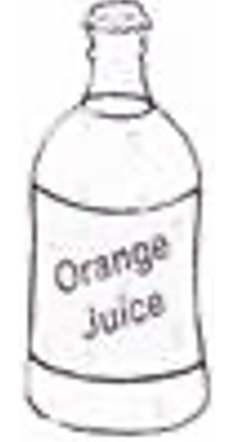
(A) From the cool air in the freezer
(B) From the moisture in the surrounding air
(C) From the orange juice
(D) From Arun's hands
Answer:
B
Water droplets are formed on the surface of juice bottle, which is taken out from a freezer due to the moisture in the surrounding air.
Q.31 . . . . .is added to kill germs in water.
(A) Talcum powder
(B) Detergent powder
(C) Chlorine
(D) All of the above
Answer:
C
Chlorine is added to kill germs in water.
Q.32 What processes is involved in the given statement?
Water → Steam / vapour
(A) Evaporation
(B) Melting
(C) Freezing
(D) Condensation
Answer:
A
During evaporation water changes to water vapour.
Q.33 Wet clothes dry faster on a
(A) humid day
(B) windy day
(C) sunny and humid day
(D) sunny and windy day
Answer:
D
Wet clothes dry fast on a sunny and windy day.
Q34. Water droplets that can be seen on the grass in winter mornings is because of
(A) the secretion of water from the leaves.
(B) the rains that take place every night.
(C) the condensation of water particles in the air.
(D) the excessive absorption of water from the soil.
Answer:
C
Water droplets that can be seen on grass in winter morning is because of the condensation of water particles in the air.
Q.35 By studying the photographs of India in newspapers and TV, we can predict dangers like cyclones and heavy rainfall. These photographs are taken by
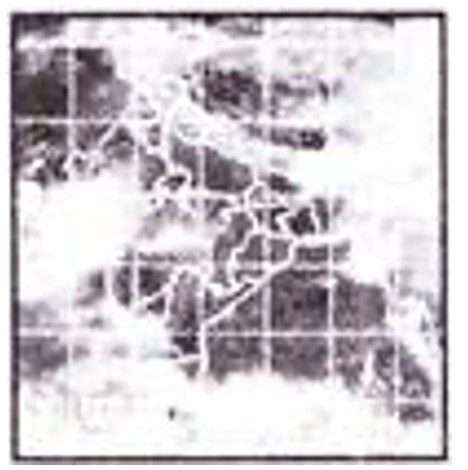
(A) aeroplanes
(B) helicopters.
(C) parachutes
(D) artificial satellites.
Answer:
D
Weather reports and photographs are taken by the help of artificial satellites.
Q.36 Which of the following causes wind to blow?
(A) The rising up of cold air.
(B) The rising up of warm air.
(C) The rising up of water vapour in the air.
(D) All of the above.
Answer:
B
Due to the heat of the sun, warm air rises and cool air rushes in to take its place. This causes the wind to blow.
Q.37 During winter it is warm
(A) in the mornings
(B) in the evenings
(C) in the afternoon
(D) All of the above
Answer:
C
It is warm during the after noon. Because the sun shines and sunlight falls directly on the Earth.
Q.38 Which of these falls in different shapes?
(A) Hailstone
(B) Fog
(C) Dew
(D) Snow flakes
Answer:
D
If the clouds are very cold, water vapour condenses to form snowflakes of different shapes.
Q.39 Which of the following causes changes in weather?
(A) The Moon
(B) The Sun
(C) Air currents
(D) Rain
Answer:
B
The sun causes changes in weather.
Q.40 Condensed water vapour which can be seen on the ground after a very cold night is the
(A) mist
(B) frost
(C) fog
(D) dew.
Answer:
B
On very cold nights, the dew freezes to form ice. This is called frost.
Free PDF download of CBSE NCERT Class 4 EVS Worksheets of Chapter with Questions and Answers